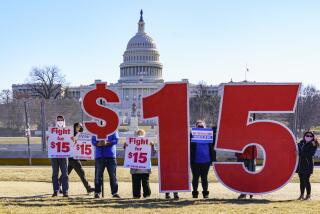Nation’s ‘Poverty Line’ Too Low, Poll Indicates : Survey: The government’s yardstick is $12,000. But the American public says a family of four requires at least $15,000 a year to get by.
- Share via
WASHINGTON — The American public believes that it takes at least $15,000 a year for a family of four to escape poverty, a figure nearly $3,000 higher than the federal government’s latest available yardstick, according to a survey issued Wednesday.
If the public’s income definition of real-life poverty were used, there would be 45 million people considered poor, compared with 32 million under the government’s measure.
“What this report highlights is the need for urgency to act on poverty in the United States,” said Ronald Pollack, executive director of Families USA Foundation, which sponsored the survey along with the Center on Budget and Policy Priorities. Both are liberal organizations active in social policy issues.
Pollack said that the survey represented the first systematic effort to ask the American public for a financial definition of poverty.
The federal government says that the poverty line income in 1988 was $6,155 for a single individual and $12,092 for a family of four. These numbers are updated annually, and new figures will be issued for 1989 later this year.
The survey issued Wednesday said that the public’s definition calls for a poverty line of $15,017 for a family of four. The figures vary by region, with the Midwest and the South at $14,235, and the Northeast at $15,486. People polled in the Western region, including California, report the highest number, $16,790.
The report, “Real Life Poverty in America,” was based on a Gallup poll of a national sample of 3,511 adults each month between July and October, 1989.
The poll asked this question: “People who have income below a certain level can be considered poor. That level is called the ‘poverty line.’ What amount of weekly income would you use as a poverty line for a family of four (husband, wife and two children) in this community?”
The average level of weekly income mentioned by people was translated into an annual income and adjusted to make it comparable to the government data for 1988.
Wednesday’s survey provides a picture of “real-life poverty,” showing dramatic differences between individuals’ assessments and the government’s definitions, said Pollack. “This is not the stereotype of who we usually think is poor,” he said. Using the poverty income definitions produced by polling, “there is a big increase in the number of whites, of old people, and of more-educated people,” Pollack said.
The official federal poverty definition, prepared in the early 1960s, assumed that the average family spent about a third of its income for food. Spending patterns have changed drastically, with food consuming a much smaller share of spending and housing taking much more. But the method for calculating poverty has not been revised.
“The study is the first time anyone went to the American public to determine where the poverty line should be set,” Pollack said.
More to Read
Sign up for Essential California
The most important California stories and recommendations in your inbox every morning.
You may occasionally receive promotional content from the Los Angeles Times.













